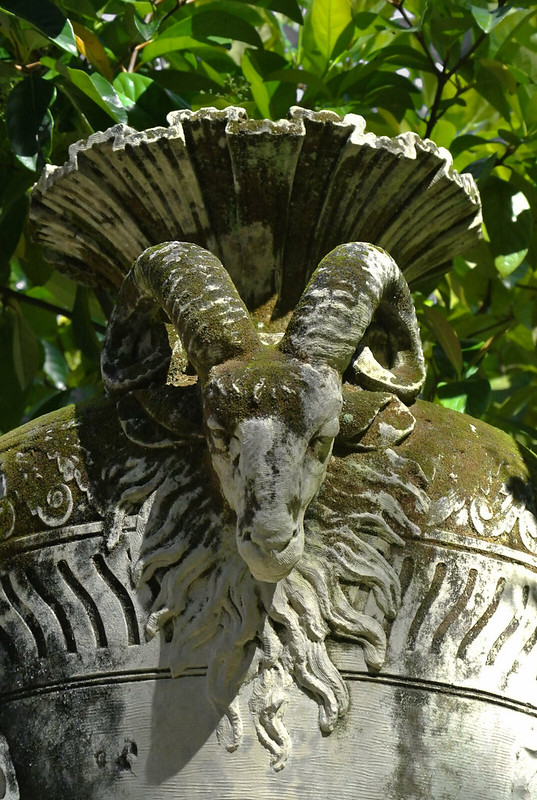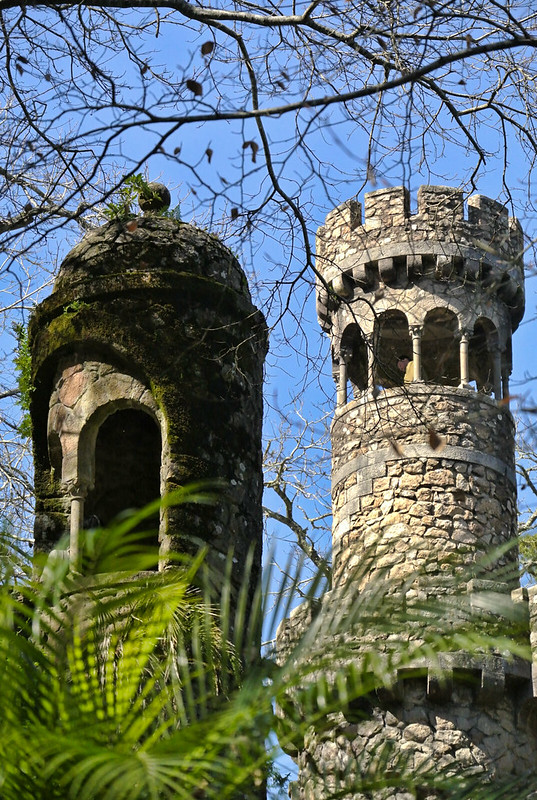Muistatteko vielä maaliskuisen matkani Lissaboniin? Vietin Lissabonissa puolitoista viikkoa, josta osan aikaa ystäväni kanssa. Yhtenä päivänä matkustimme Sintraan, jonka vuorenrinteillä kohoaa useita ikivanhoja linnoja. Meillä oli ajatuksissa vierailla päivän aikana kolmessa linnassa, ja että kävelisimme parin kilometrin matkan ensimmäiselle etapille. Sintraan päästyämme päätimme, että emme todellakaan lähde vuorenrinteen kävelypoluille seikkailemaan vaan hyppäsimme bussiin kohti Quinta da Regaleiraa eli Regaleiran palatsia. Quinta da Regaleira oli listallamme ensisijainen. Matka bussilla kesti kiemuraisia ja kapeita teitä pitkin melko kauan ja sitten piti vielä kavuta muutama sata metriä sisäänkäynnille. Saatuamme käsiimme paikan kartan, tajusimme että koko päivä meneekin ainoastaan Quinta da Regaleiran valtavan alueen (4 hehtaaria) tutkimisessa. Palatsin ympärillä on nimittäin valtavasti luolastoja ja puutarhoja täynnä sammaloituneita kivirakennelmia, vehreää kasvistoa, valtavia puita sekä isoja ja pieniä polkuja. Vietimme useita tunteja ylös ja alas vuorenrinteitä kiiveten ja koko ajan valokuvaten. Valokuvani tosin eivät tee paikalle ollenkaan oikeutta. Vaikka päivä oli jaloille erittäin raskas, oli se yksi parhaimmista päivistä koko reissulla. Ylhäällä vuoristossa oli niin vehreää, kaunista ja silti rauhallista muista turisteista huolimatta.
Quinta da Regaleira on suuri valkoinen, goottilaistyylinen palatsi, jonka rikas portugalilainen liikemies Carvalho Monteiro rakennutti vuonna 1904. Carvalho oli viehättynyt okkultismista ja muinaisista salaseuroista, joten palatsin puutarhojen uumenista löytyy piilotettuja tunneleita ja kätkettyä symboliikkaa. Tunnetuin näistä lienee initiaatiokaivo The Initiation Well, joka symbolisoi temppeliherrain ritarikunnan initiaatioseremoniaa. Kaivon sisällä on spiraalimainen portaikko, joka johtaa 27 metriä alaspäin maan uumeniin. Kaivon pohjalta pääsee pitkiin, joka puolelle ulottuviin maanalaisiin tunneleihin/luolastoihin. Initiaatiokaivo oli totisesti koko paikan kiinnostavin yksityiskohta.
Do you still remember my trip to Lisbon in March? I was there for a week and a half: a few days with a friend and then the rest of the trip on my own. One day my friend and I went to a nearby city called Sintra that's filled with old castles. We thought we'd be able to visit three castles or so during the day and that maybe we would walk. Once we got there we decided that we would certainly not walk up the steep mountainside and instead hopped on a bus to Quinta da Regaleira. That was the one palace we wanted to see the most. It took ages to get up the mountainside with the bus and then a few hundred meters on foot up the hill to the entrance.
Quinta da Regaleira is a white palace with a gothic style facade, constructed in 1904 by Carvalho Monteiro. He was a wealthy Portuguese businessman and because of his fascination with ancient secret orders (f.e. the Knights Templar, the Masons) the gardens all around the palace have hidden tunnels and concealed symbolism. The most obvious one is The Initiation Well. It symbolises the initiation ceremony of the Knights Templar. Inside the well a spiraling stone stairwell descents 27 meters into the ground and once you get to the bottom of the well there are various underground tunnels/caves. Quinta da Regaleira was reclaimed by Sintra government in 1997 and opened to the public in 1998. The grounds of Quinta da Regaleira are huge (4 hectares) which we found out when we got a hold of the map. No other castles that day. It was so green, beautiful and serene up there even with all the other turists. My photos don't do the place justice at all and I have lots of crappy photos not worth publishing of some really great spots. We explored the grounds for hours, walking up and down the mountainside photographing all the while. There were so many lovely gardens with a myriad of flowers, huge trees, caves and ancient stone towers. The massive white palace was beautiful and the Initiation Well probably the most interesting feature in the entire place.




















Ei kommentteja:
Lähetä kommentti